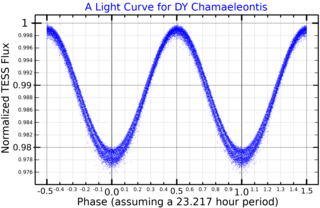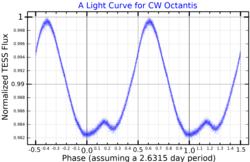
HD 24479, also designated as HR 1204, is a solitary, bluish-white hued star located in the northern circumpolar constellation Camelopardalis. The star is visible to the naked eye with an apparent visual magnitude of 5.04. Based on Gaia DR3 parallax measurements, it is located 385 light years from the Sun. However, it is receding with a somewhat constrained heliocentric radial velocity of 4.6 km/s. At its current distance, HD 24479's brightness is diminished by 0.29 magnitudes due to interstellar dust.
HD 96146 is a binary star located in the southern constellation Antlia. The system has a combined apparent magnitude of 5.41, making it visible to the naked eye under ideal conditions. Parallax measurements from the Gaia spacecraft place the pair at a distance of 710 light years with a large margin of error. It is currently receding with a poorly constrained heliocentric radial velocity of 4.7 km/s.
HD 86267, also known as HR 3932, is a solitary orange-hued star located in the southern constellation Antlia. It has an apparent magnitude of 5.82, allowing it to be faintly seen with the naked eye. Parallax measurements place it a distance of 514 light years and it is currently receding with a heliocentric radial velocity of 3.7 km/s.
HD 126209, also known as HR 5389, is a solitary, orange hued star located in the southern circumpolar constellation Apus. It has an apparent magnitude of 6.06, making it faintly visible to the naked eye under ideal conditions. Based on parallax measurements from the Gaia spacecraft, the object is estimated to be 560 light years distant. It appears to be approaching the Solar System with a fairly constrained heliocentric radial velocity of −8.1 km/s. De Mederios et al. (2014) found the radial velocity to be variable, making it a probable spectroscopic binary. Eggen (1993) lists it as a member of the old disk population.
HD 30080, also known as HR 1509, is a solitary, orange hued star located in the southern constellation Caelum, the chisel. It has an apparent magnitude of 5.66, allowing it to be faintly visible to the naked eye. Parallax measurements from Gaia DR3 place the object at a distance of 612 light years. It appears to be approaching the Solar System with a heliocentric radial velocity of −3.8 km/s. Eggen (1989) lists it as a member of the thick disk population.

HD 26764, also known as HR 1314 or rarely 14 H. Camelopardalis, is a solitary white hued star located in the northern circumpolar constellation Camelopardalis. It has an apparent magnitude of 5.19, making it faintly to the naked eye if viewed under good conditions. Gaia DR3 parallax measurements place the object at a distance of 266 light years and is drifting closer with a poorly constrained heliocentric radial velocity of 3 km/s. At its current distance, HD 26764's brightness is diminished by 0.26 magnitudes due to interstellar dust.
HD 75116, also known as HR 3491, is a solitary, orange hued star in the southern circumpolar constellation Volans, the flying fish. It has an apparent magnitude of 6.31, placing it near the limit for naked eye visibility. Parallax measurements from the Gaia spacecraft place the star relatively far at a distance of 930 light years. It appears to be approaching the Solar System, having a heliocentric radial velocity of −17.5 km/s.

Eta Octantis, Latinized from η Octantis, is a solitary star located in the southern circumpolar constellation Octans. It has an apparent magnitude of 6.19, making it faintly visible to the naked eye. The object is situated at a distance of 358 light years but is approaching the Solar System with a heliocentric radial velocity of −1.7 km/s.

Tau Octantis, Latinized from τ Octantis, is a solitary star in the southern circumpolar constellation Octans. It has an apparent magnitude of 5.50, allowing it to be faintly seen with the naked eye. The object is located at a distance of 480 light years but is receding with a heliocentric radial velocity of 31 km/s.

Xi Octantis, Latinized from ξ Octantis, is a solitary variable star in the southern circumpolar constellation Octans. It has an apparent magnitude of about 5.3, allowing it to be faintly seen with the naked eye; however, this varies slightly. Located 514 light years away, the object is receding with a heliocentric radial velocity of 22 km/s.
HD 75171, also known as HR 3495, is a solitary, white hued star located in the southern constellation of Volans. It has an apparent magnitude of 6.02, making it faintly visible to the naked eye under ideal conditions. The object is relatively close at a distance of 191 light years but is receding with a heliocentric radial velocity of 10.7 km/s. Eggen (1995) lists it as a probable member of the Hyades Supercluster.

WZ Columbae, also known as HD 38170, is a solitary, bluish-white hued star located in the southern constellation Columba, the dove. It has an apparent magnitude of 5.28, allowing it to be faintly visible to the naked eye. Based on parallax measurements from the Gaia spacecraft, the object is about 365 light years distant. It appears to be receding from the Solar System, having a heliocentric radial velocity of 36.3 km/s.
HD 31529, also known as HR 1584, is a solitary, orange hued star located in the southern constellation Caelum, the chisel. It has an apparent magnitude of 6.09, making it faintly visible to the naked eye if viewed under ideal conditions. This object is located relatively far at a distance of 932 light years based on parallax measurements from Gaia DR3, but is receding with a heliocentric radial velocity of 28.4 km/s. Eggen (1989) lists it as a member of the old disk population.
HD 26670, also known as HR 1305, is a star located in the northern circumpolar constellation of Camelopardalis, the giraffe. The object has been designated as 26 H. Camelopardalis, but is not commonly used in modern times. It has an apparent magnitude of 5.70, allowing it to be faintly visible to the naked eye. Based on parallax measurements from Gaia DR3, the object is estimated to be 491 light years away from the Solar System. It appears to be slowly receding with a heliocentric radial velocity of 0.4 km/s.

23 Leonis Minoris is a solitary, bluish-white hued star located in the northern constellation Leo Minor. It is positioned 7° south and 11" west from β Leonis Minoris. It is rarely called 7 H. Leonis Minoris, which is its Hevelius designation.

40 Leonis Minoris is a white hued star located in the northern constellation Leo Minor. It is rarely called 14 H. Leonis Minoris, which is the designation given by Polis astronomer Johann Hevelius.

HD 198716, also known as HR 7987 or 33 G. Microscopii, is a solitary star located in the southern constellation Microscopium. Eggen (1993) lists it as a member of the Milky Way's old disk population.

HD 118285, also known as HR 5115, is a variable star located in the southern circumpolar constellation Chamaeleon. DY Chamaeleontis is its variable star designation. It has an average apparent magnitude of 6.32, placing it near the limit for naked eye visibility. The object is located relatively far at a distance of 864 light years based on Gaia DR3 parallax measurements but is receding with a heliocentric radial velocity of 18 km/s. At its current distance, HD 118285's brightness is diminished by 0.58 magnitudes due to interstellar dust.

HD 168592, also designated as HR 6862 or rarely 7 G. Coronae Australis, is a solitary star located in the southern constellation Corona Australis. It is faintly visible to the naked eye as an orange-hued star with an apparent magnitude of 5.07. Gaia DR3 parallax measurements place it at a distance of 490 light years and is currently receding with a heliocentric radial velocity of 18 km/s. At its current distance, HD 168592's brightness is diminished by 0.38 magnitudes due to interstellar dust. It has an absolute magnitude of −0.76.

HD 31134, also designated as HR 1561, is a solitary star located in the northern circumpolar constellation Camelopardalis, the giraffe. It is faintly visible to the naked eye as a white-hued star with an apparent magnitude of 5.74. Gaia DR3 parallax measurements place it 473 light years away. It appears to be approaching the Solar System with a heliocentric radial velocity of −15.1 km/s. At its current distance, HD 31134's brightness is diminished by 0.35 magnitudes due to interstellar dust. It has an absolute magnitude of +0.19.








